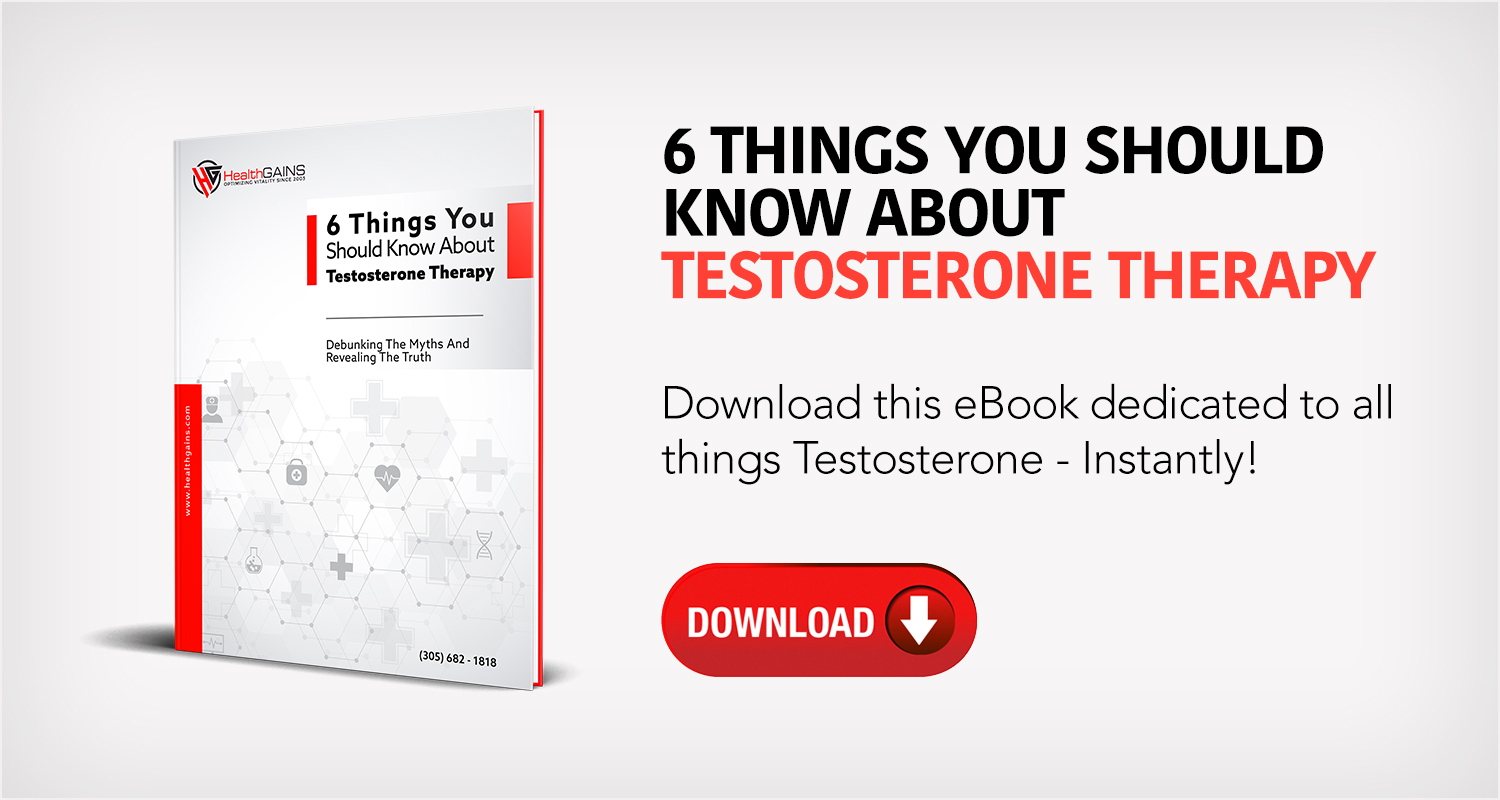
Men who have low testosterone levels could experience several problematic health consequences. While these issues could interfere with their personal life, professional ambitions, and sense of self, these problems could be alleviated through testosterone therapy. Testosterone therapy could help a man achieve several health-related goals.
HealthGAINS wellness providers not only help patients understand how testosterone therapy could help them but also explain the possible causes of their low testosterone (low-T) levels. Almost 40% of men[1] who reach the age of 45 may suffer from low-T, as well as a significant number of men under the age of 45.
Testosterone therapy for men could be a way for patients to reduce or eliminate the negative effects of low testosterone levels. Aging can take a toll on the male body, and losing testosterone over time is just one of the possible symptoms of aging. Men who have pre-existing medical conditions (like diabetes) could also benefit from testosterone therapy.
Speaking with a HealthGAINS wellness provider could help one better understand the benefits of testosterone therapy. To learn more, contact HealthGAINS by calling (305) 682-1818.
What Does Testosterone Therapy Help With?
What Does Testosterone Therapy Help With?
Testosterone therapy may address the symptoms that are associated with low testosterone levels. Testosterone plays a vital part in many biological functions for both men and women, but men may be particularly affected by low levels of testosterone. It is known as the male sex hormone and plays a central role in men’s overall health.[2]
Symptoms of low testosterone include:[3]
Disturbances in Sleep Patterns
Not getting enough sleep can:[4]
- Make one feel emotionally unwell
- Impede one’s ability to learn new information
- Impair one’s ability to make good decisions
- Cause one to be more emotionally volatile
These are significant issues that can all be tied back to a lack of sleep. One may also consider how a lack of sleep could be a symptom of low testosterone levels.
Diminished Bone Health
The health of one’s bones is worth paying attention to. With age or certain conditions, bones can become weaker, thinner, and less dense. This could make it more difficult to exercise and lead to fractures. Diminished bone health could also be the result of low testosterone.
Osteoporosis is a condition associated with poor bone health.
Osteoporosis can cause:[5]
- A person to get shorter
- Unsightly changes in posture
- Bones that are more susceptible to breaking
- Pain in one’s back
The older one gets, the more likely they are to develop osteoporosis. Worsening bone health may also correlate with decreased testosterone levels.
Poor Mental Health
Low testosterone levels can affect both the body and mind. When a man struggles with low testosterone, he simply may not feel like himself.
Low testosterone could lead to:
- Depression
- General sadness
- Irritability
- Difficulty concentrating
- Trouble remembering certain things
Depression can be a catalyst for serious problems throughout a person’s life. It may lead to substance abuse, poor physical health, and suicide.
These are just a few of the possible symptoms of low testosterone. Testosterone therapy seeks to remedy these symptoms. Those with questions about specific conditions may speak with a HealthGAINS wellness provider about whether testosterone therapy could be effective for them.

Is Testosterone Therapy Expensive?
Is Testosterone Therapy Expensive?
Before undergoing testosterone therapy, a man may have concerns regarding the treatment’s cost.
Ultimately, whether a patient considers testosterone therapy to be expensive may depend on:
- The budget they generally allocate for their own wellbeing
- Their income
- What they consider the cost of foregoing testosterone therapy to be
The cost of testosterone therapy may vary from one patient to the next.
Some of the factors to consider when calculating the cost of testosterone therapy include:[6]
- The dosage of each injection
- The frequency of injections
- The specific goals one hopes to achieve from testosterone therapy
- Other details of a customized testosterone therapy treatment plan
- How quickly a patient’s body responds to therapy
When considering the cost of testosterone therapy, one may ask himself, “What is the cost of not undergoing testosterone therapy?”
Low-T levels are proven to affect nearly every aspect of a man’s life. His sexual potential, energy levels, and self-esteem can all be affected by low testosterone.
This hormonal deficit can also result in:
Obesity
The cost of being overweight may manifest itself in several ways. One’s bones, joints, and muscles may be taxed immensely if they are forced to carry excess weight over long periods of time. Therefore, being overweight due to low testosterone could lead to serious health conditions in the musculoskeletal system.
Being overweight may also cause heart disease, which can be fatal.[7] Cardiovascular disease may limit one’s ability to engage in physical activity and could have permanent health effects.
The potential cost of being overweight, particularly over a sustained period of time, may take a financial, physical, and psychological toll. These consequences are all reasons why patients should consider testosterone therapy.
Muscle and Bone Deficits
Being unable to build muscle is one possible consequence of low testosterone. Along with diminished bone health, a person with the symptoms of low-T may be susceptible to both muscle and bone injuries.
A person with poor bone or muscle health could:
- Suffer one or more broken bones
- Develop muscle disorders[8]
- Be unable to work out or engage in physical activities as they would like to
- Develop mental health problems related to poor physical health
- Experience an overall decline in their quality of life
The health care costs that arise from low-T could be more expensive than testosterone therapy itself. Anyone who is wondering about the cost of testosterone therapy for men should consider calling HealthGAINS to learn more.
To learn more about receiving treatment, call HealthGAINS at (305) 682-1818.
When Do You Start Seeing the Results of Testosterone Therapy?
When Do You Start Seeing the Results of Testosterone Therapy?
The time it takes for patients to see the results of testosterone therapy may vary for each patient. Every patient is unique.
However, factors that may influence the time it takes for a patient to see the results of testosterone therapy include:
- Whether the patient has underlying health conditions relevant to their low hormone levels
- What the patient’s general health is
- The goals that a patient hopes to achieve from testosterone therapy
- How the patient’s body responds to treatment
Testosterone therapy generally takes a matter of weeks to begin producing results in men.[9] Patients will generally undergo testosterone therapy for a time spanning six months to a year. The duration in which a patient receives treatment may determine how quickly they are able to achieve results.
A HealthGAINS wellness professional will monitor a patient as they undergo testosterone therapy.
Some of the ways that they may help a patient assess their progress include:
Speaking with a HealthGAINS Wellness Provider About Their Goals
As with any treatment, progress must be gauged against some criteria. A patient who is receiving testosterone therapy may speak with their doctor before treatment begins.
This may allow them to:
- Understand their therapy-related goals
- Understand how soon they can see results
It is important to know that every patient is unique, and the timeframes for seeing results are not written in stone. A patient should consult with their HealthGAINS wellness team to get a better answer regarding their therapy’s timeframe.
Monitoring Their Progress
One may receive periodic testosterone injections as part of their therapy, and a HealthGAINS wellness provider will track their progress as therapy continues.
They may rely on self-reporting from the patient, which may include information regarding the patient’s energy levels, cognitive function, and workout results. They may also be able to track progress through more observable measures, such as body fat measurements.
As it becomes clear how a patient is responding to therapy, their HealthGAINS wellness professional will evaluate their progress. When a patient receives testosterone therapy through HealthGAINS, their wellness team will consider their goals, how quickly they are being achieved, and what changes could advance one’s objectives.
Is Testosterone Replacement Therapy Safe?
Is Testosterone Replacement Therapy Safe?
Testosterone replacement therapy is safe, so long as patients ensure that they are receiving treatment from a reputable source. There are several ways that HealthGAINS wellness professionals aim to ensure the safety of all patients.
Some measures that HealthGAINS takes to make testosterone therapy safe includes:
Using Only Prescription-Grade Testosterone
Receiving testosterone through a prescription is the only way to ensure that testosterone therapy is legitimate.
Patients should be wary of:
- Over-the-counter pills or products that claim to restore or boost testosterone levels
- Testosterone from an unspecified source
- Any form of testosterone that is not acquired through a prescription
HealthGAINS wellness providers only use prescription-grade testosterone. They can speak more with patients about the dangers of testosterone that is not sourced through a prescription, as well as the benefits of using prescription-grade testosterone for therapy.
Maintaining On-Site Staff
HealthGAINS has staff on hand who are knowledgeable about testosterone therapy.
Such on-site staff may be able to:
- Answer any questions that patients have about how testosterone therapy is administered
- Answer any questions that patients have about the safety of testosterone therapy
- Monitor a patient’s testosterone therapy
- Explain why HealthGAINS’ method of conducting testosterone therapy adheres to best safety practices
Testosterone therapy is as safe as the provider who is administering treatment, which is why patients should contact HealthGAINS wellness providers about testosterone therapy. HealthGAINS providers put patients’ safety first, which may be more than other testosterone therapy providers can honestly claim.
Some of the possible dangers of receiving treatment from an irresponsible provider of testosterone therapy include:
- The testosterone being used could contain foreign substances that are bad for a patient’s health.
- The testosterone used may not be legitimate or effective.
- The provider may not have the necessary level of medical knowledge to administer treatment safely.
- The facility where a patient receives treatment may not be sterile.
- One’s health may be put at risk by any therapy-related problem.
No patient should take their health for granted. Receiving testosterone therapy from a HealthGAINS wellness provider means receiving prescription-strength testosterone in a safe environment from trained professionals.
What Are the Side Effects of Testosterone Therapy?
What Are the Side Effects of Testosterone Therapy?
When administered correctly, the side effects of testosterone therapy can be managed. HealthGAINS wellness providers do not make compromises when it comes to patients’ safety–– and for a good reason. Those who do not consider a patient’s overall health when administering testosterone injections could unnecessarily expose the patient to a greater risk of side effects.
Some of the potential side effects of misusing testosterone include:[10]
- Harm to the muscles in a patient’s heart
- Acne
- Headaches
- Difficulty sleeping
- Changes in one’s emotional state
- Weight gain
- Increased blood pressure
Each of these side effects reinforces why testosterone therapy must be administered in the most responsible manner possible. Like any medical treatment, testosterone therapy has the potential for side effects, but HealthGAINS wellness providers do everything in their power to help patients avoid them.
Some of the ways that HealthGAINS wellness providers aim to protect patients from harm include:
Keeping the Patient Informed
Every individual has a right to govern over their own body, and this includes being informed about the treatments that they undergo.
When it comes to their testosterone therapy, a HealthGAINS wellness provider will:
- Explain how therapy works
- Explain what measures they are taking to keep a patient safe
- Explain what their plan for treatment is
- Keep the patient informed about their biological response to treatment
- Ensure that the patient is comfortable with all aspects of their testosterone therapy
HealthGAINS providers work in a collaborative manner with patients. Their goal is not only to help patients achieve results but to do so with minimal side effects.
Maintaining a Health-First Approach
HealthGAINS wellness professionals understand the harm that can come from misusing testosterone. When a patient comes to the facility for treatment, a wellness provider will test their hormone levels and perform a physical examination. From there, they will have a better understanding of how a patient’s body is responding to treatment. At HealthGAINS, patients’ safety comes first.
Contact HealthGAINS to learn more about testosterone therapy by calling (305) 682-1818.
How Often Do I Need Testosterone Therapy?
How Often Do I Need Testosterone Therapy?
The frequency with which a patient receives testosterone therapy will depend on their individualized treatment plan.
A HealthGAINS wellness provider will take an approach that:
- Aims to achieve the results patients are seeking
- Ensures patients’ overall health and safety
HealthGAINS provides tailor-made treatment plans that meet patients’ needs. Providers understand how to monitor patients’ health and how to adjust the frequency of testosterone injections.
The following are criteria that a HealthGAINS testosterone therapy provider may consider when determining how often someone may need testosterone therapy.
The Patient’s Age
Age may be a reason why a person seeks out testosterone therapy, as aging can lead to the natural loss of testosterone over time. Age must also be considered when determining how frequently a patient should receive testosterone injections.
It is not necessarily true that an older patient should receive testosterone injections more frequently. Every patient must be viewed through their overall health profile.
Any Pre-Existing Health Conditions
When a patient comes to HealthGAINS for treatment, a wellness provider will determine whether any pre-existing health conditions could impact their therapy’s success. Certain conditions may call for a more conservative approach to testosterone therapy and could therefore impact the frequency with which a patient receives testosterone injections.
Testosterone therapy for men is intended to improve patients’ overall health and quality of life. Understanding a patient’s health profile before beginning testosterone therapy allows wellness providers to make customized treatment plans.
How a Patient Responds to Testosterone Injections
Patients who undergo testosterone therapy want results, whether it is muscle gain, fat loss, or greater energy levels. As patients progress through their testosterone therapy treatments, they and their HealthGAINS wellness providers will monitor whether those results are being realized, how quickly they emerge, and to what extent they are being achieved.
If results come quickly and meet a patient’s goals, then this may affect the frequency and duration of their testosterone injections. Conversely, if a patient does not see results as quickly as they hoped, then their HealthGAINS wellness professional may advise changes in their treatment plan.
Every patient has a unique experience with testosterone therapy. While many men see positive results after beginning treatment, the path that each patient takes to achieve their goals is unique.
When Do I Need Testosterone Therapy?
When Do I Need Testosterone Therapy?
There are several possible indicators that may signal low testosterone levels.
Some of the indicators that a person could benefit from testosterone therapy include:
- A lack of energy that gets in the way of one’s normal routine
- Noticeable weight gain
- Difficulty losing weight after a sustained effort
- Cognitive problems that do not go away on their own
- Loss of enjoyment of life, which may include depression
These may be signs that a man is suffering from low testosterone. Left unaddressed, these issues could have serious consequences. When one considers the potential harm of these symptoms, they may consider whether it is time to try testosterone therapy for men.
Testosterone therapy can help address:
Energy Loss
Everyone requires energy just to get through their day. To reach one’s full potential, a person may need all the energy they can get. When testosterone levels fall, however, their energy levels may fall as well.
Diet is a key component in providing energy to men and women alike.[11] Proper rest may also help a person retain as much energy as possible. While some may turn to caffeine to gain energy, these options may come with significant downsides.
Those who lack energy could benefit from testosterone therapy. By restoring his energy levels through testosterone replacement therapy, a man may be able to get more done throughout his day.
Weight Gain
The danger of gaining and holding onto excess fat is well-known.
Retaining abdominal fat could lead to:[12]
- Certain cancers
- Dementia
- Heart disease
Some men are more likely to gain abdominal fat than women. Testosterone therapy may be a way to help men lose fat, and therefore to reduce their risk of developing serious health conditions linked to weight gain.
If a patient is experiencing any of the adverse symptoms that testosterone therapy could help alleviate, then it may be time for them to consider testosterone therapy. Contact HealthGAINS for more information about how to receive treatment by calling (305) 682-1818.
Does Testosterone Therapy Hurt?
Does Testosterone Therapy Hurt?
Testosterone therapy may not generally be considered something that “hurts.” Rather, it may be mildly uncomfortable, depending on one’s feelings about receiving injections. One’s definition of what hurts and what does not may be far different from another person’s perspective. Pain is also relative.
Speaking with a HealthGAINS wellness professional may give a prospective patient a better understanding of what receiving testosterone injections is like. They may be able to find out what the usual patient reaction is to injections in general.
A HealthGAINS wellness professional may take any of the following measures to reduce the amount of discomfort that a patient could feel.
This may include:
- Ensuring that a patient is comfortable throughout treatment through verbal communication
- Ensuring that a patient is comfortable with the injection site
- Using different injection sites over the course of multiple treatment sessions
- Using numbing agents for patients who are sensitive to injections
Other steps may be available to ensure that a patient is as comfortable as possible when receiving testosterone therapy for men. When considering the benefits of testosterone therapy, one may not even think about the discomfort associated with treatment.
Testosterone therapy may help patients avoid:
Heart Attacks
A heart attack may be extremely painful and may be the result of heart disease.
A heart attack may cause:[13]
- Heartburn
- Pain in one’s abdomen
- A clenching feeling in one’s chest
- Tightness, pressure, and pain throughout one’s upper body
A heart attack could also result in death. Patients who undergo testosterone therapy may see the pain of injections as minimal when considering their long-term goals.
Broken Bones
Some men may undergo testosterone therapy as a way to improve their bone health. One benefit of better bone health may mean less susceptibility to broken bones. Breaking a bone may be extremely painful and could lead to secondary conditions, like arthritis. Again, these outcomes may seem far worse than the discomfort of a testosterone injection.
Each patient must determine for themselves whether receiving an injection is painful. However, while doing so, they should determine the benefits of testosterone therapy.
Who Shouldn’t Get Testosterone Therapy?
Who Shouldn’t Get Testosterone Therapy?
There are many individuals who could benefit greatly from testosterone therapy. However, a patient must understand that they may not be an ideal candidate for such treatment. A HealthGAINS wellness professional can address patients individually about circumstances that may make it unwise to undergo testosterone therapy.
Certain health conditions may prevent a man from undergoing testosterone therapy in a way that is safe.
Men who may want to avoid treatment include those who:[14]
- Have a severely enlarged prostate
- Are at a heightened risk of developing prostate cancer
- Have already developed heart disease
- Have suffered a heart attack
- Have cardiovascular issues
These are not necessarily reasons to rule out testosterone therapy; they are reasons to proceed with care. Any patient considering testosterone therapy should be honest with their HealthGAINS wellness provider about their medical history.
Men who do not have relevant health conditions must also understand that their own actions could determine whether testosterone therapy is right for them.
A patient may not benefit from testosterone therapy if:
- They are not willing to go to a trained medical practitioner (such as a HealthGAINS wellness provider) who they know will administer treatment in a safe manner.
- They intend to misuse testosterone.
- They are combining prescription-grade testosterone with products that are not being issued safely, such as over-the-counter testosterone supplements.
HealthGAINS wellness providers will also speak with patients about the ways that they can maximize the value of their therapy. In some cases, they may advise a patient to take certain measures before beginning testosterone therapy.
In any case, a patient may be well-served by:
- Maintaining a healthy diet
- Getting regular exercise
- Ensuring that they are well-rested
- Avoiding certain behaviors that could interfere with the goals of testosterone therapy
Knowing how to get the most out of testosterone therapy is information that patients should be privy to. HealthGAINS wellness professionals want their patients to achieve strong results from their therapy. They give patients the necessary information to help them reach their wellness goals.
One may decide whether testosterone therapy is right for them by contacting a HealthGAINS wellness provider. From there, they can provide more information regarding testosterone therapy in general, its benefits, and its side effects.
Contact HealthGAINS Today
Low testosterone levels can make a man feel less than his best. Whether it is the result of aging, genetics, or pre-existing medical conditions, a man can see a marked improvement in his life by undergoing testosterone replacement therapy.
Men whose testosterone levels are falling may experience:
- A diminished sex drive
- Difficulty achieving and maintaining erections (which may be a sign of erectile dysfunction)
- Chronic fatigue
- Loss of muscle mass
- Weight gain
- Problems with memory
- Slower cognitive processing
- Depression, anxiety, and other mental health complications
These symptoms, each of which may be tied to low testosterone levels, illustrate how important the hormone is for men’s health. Yet, there is help available. Since 2003, HealthGAINS has been helping men reach their full sexual, professional, and personal potential. Upon starting testosterone therapy, a man can see improvements in his quality of life in a matter of weeks.
Low-T does not have to be permanent. Testosterone therapy for men may help patients restore the testosterone that they have lost due to aging or specific medical conditions. Contact HealthGAINS to learn more by calling (305) 682-1818.
[1] https://my.clevelandclinic.org/health/diseases/15603-low-testosterone-male-hypogonadism#:~:text=How%20common%20is%20low%20testosterone,certain%20medications%2C%20age%20and%20illness.
[2] https://www.nih.gov/news-events/nih-research-matters/understanding-how-testosterone-affects-men
[3] https://www.healthline.com/health/side-effects-of-low-testosterone#emotional-changes
[4] https://www.nhlbi.nih.gov/health-topics/sleep-deprivation-and-deficiency#:~:text=Sleep%20plays%20an%20important%20role,pressure%2C%20diabetes%2C%20and%20stroke.
[5] https://www.mayoclinic.org/diseases-conditions/osteoporosis/symptoms-causes/syc-20351968
[6] https://healthgains.com/hormone-therapy/testosterone-therapy-for-men/how-much-does-testosterone-therapy-cost/
[7] https://www.who.int/news-room/q-a-detail/obesity-health-consequences-of-being-overweight#:~:text=Being%20overweight%20or%20obese%20can,endometrial%2C%20breast%20and%20colon).
[8] https://medlineplus.gov/muscledisorders.html
[9] https://healthgains.com/hormone-therapy/testosterone-therapy-for-men/#:~:text=Most%20men%20start%20to%20feel,six%20months%20to%20a%20year.
[10] https://www.health.harvard.edu/drugs-and-medications/testosterone–what-it-does-and-doesnt-do
[11] http://diet.mayoclinic.org/diet/eat/dietary-sources-of-energy
[12] https://www.nytimes.com/2018/06/11/well/live/belly-fat-health-visceral-fat-waist-cancer.html
[13] https://www.mayoclinic.org/diseases-conditions/heart-attack/symptoms-causes/syc-20373106
[14] https://www.health.harvard.edu/mens-health/is-testosterone-therapy-safe-take-a-breath-before-you-take-the-plunge#:~:text=Be%20mindful%20of%20unknown%20risks,risk%20factors%20for%20heart%20problems.




